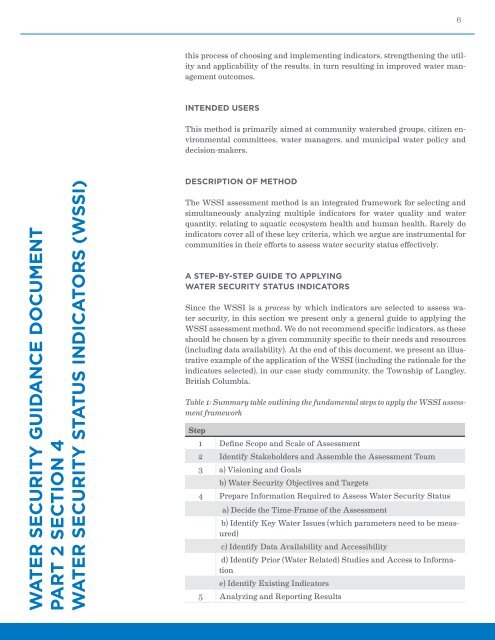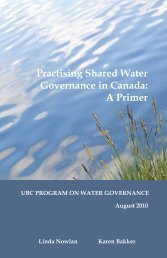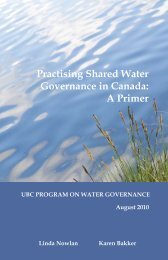Water Security Status Indicators - Program on Water Governance
Water Security Status Indicators - Program on Water Governance
Water Security Status Indicators - Program on Water Governance
You also want an ePaper? Increase the reach of your titles
YUMPU automatically turns print PDFs into web optimized ePapers that Google loves.
WATER SECURITY GUIDANCE DOCUMENT<br />
PART 2 SECTION 4<br />
WATER SECURITY STATUS INDICATORS (WSSI)<br />
this process of choosing and implementing indicators, strengthening the utility<br />
and applicability of the results, in turn resulting in improved water management<br />
outcomes.<br />
INTENDED USERS<br />
This method is primarily aimed at community watershed groups, citizen envir<strong>on</strong>mental<br />
committees, water managers, and municipal water policy and<br />
decisi<strong>on</strong>-makers.<br />
DESCRIPTION OF METhOD<br />
The WSSI assessment method is an integrated framework for selecting and<br />
simultaneously analyzing multiple indicators for water quality and water<br />
quantity, relating to aquatic ecosystem health and human health. Rarely do<br />
indicators cover all of these key criteria, which we argue are instrumental for<br />
communities in their efforts to assess water security status effectively.<br />
A STEP-BY-STEP GUIDE TO APPLYING<br />
WATER SECURITY STATUS INDICATORS<br />
Since the WSSI is a process by which indicators are selected to assess water<br />
security, in this secti<strong>on</strong> we present <strong>on</strong>ly a general guide to applying the<br />
WSSI assessment method. We do not recommend specific indicators, as these<br />
should be chosen by a given community specific to their needs and resources<br />
(including data availability). At the end of this document, we present an illustrative<br />
example of the applicati<strong>on</strong> of the WSSI (including the rati<strong>on</strong>ale for the<br />
indicators selected), in our case study community, the Township of Langley,<br />
British Columbia.<br />
Table 1: Summary table outlining the fundamental steps to apply the WSSI assessment<br />
framework<br />
Step<br />
1 Define Scope and Scale of Assessment<br />
2 Identify Stakeholders and Assemble the Assessment Team<br />
3 a) Visi<strong>on</strong>ing and Goals<br />
b) <str<strong>on</strong>g>Water</str<strong>on</strong>g> <str<strong>on</strong>g>Security</str<strong>on</strong>g> Objectives and Targets<br />
4 Prepare Informati<strong>on</strong> Required to Assess <str<strong>on</strong>g>Water</str<strong>on</strong>g> <str<strong>on</strong>g>Security</str<strong>on</strong>g> <str<strong>on</strong>g>Status</str<strong>on</strong>g><br />
a) Decide the Time-Frame of the Assessment<br />
b) Identify Key <str<strong>on</strong>g>Water</str<strong>on</strong>g> Issues (which parameters need to be measured)<br />
c) Identify Data Availability and Accessibility<br />
d) Identify Prior (<str<strong>on</strong>g>Water</str<strong>on</strong>g> Related) Studies and Access to Informati<strong>on</strong><br />
e) Identify Existing <str<strong>on</strong>g>Indicators</str<strong>on</strong>g><br />
5 Analyzing and Reporting Results<br />
6







